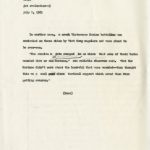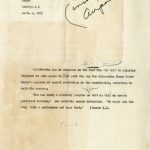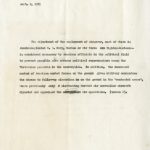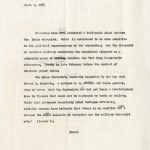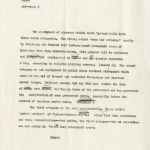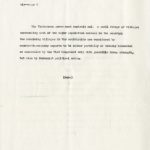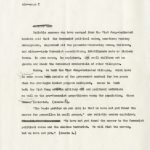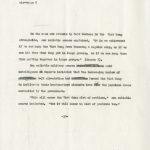1965, July 8, “American Jet Aircraft”
deepe
jet evaluation–1
july 8, 1965
SAIGON–American jet aircraft are being effectively used to block the Communist Viet Cong’s thrust into the crucia–l third and final stag phase of the war.
“Nobody thought that five-hundred-mile-an-hour jets could be used against guerrillass–until they were first tried,” one American jet pilot explained. “But on our first strike, there was a thunder of secondary explosions from the target. We had hit a Viet Cong ammo depot in their stronghold jungled stronghold areas.”
(More)
Reliable military sources say that the American jets have cut in half the reaction time of flying from base to an outpost or town under a ttack , compared to the slower o prop-driven aircraft. The stability of the aircraft, and not its speed, is a major factor in determining the accuracy of the bombing raids, these sources bliev and these sources say that jets are more stable firing platform than are commotion pro-dr slower prop-driven aircraft. Whil Since the jets are considered to fly too fast for spotting Viet Cong guerrilla targets, they are usually directed only onto the target by sp slow-moving spotter aircraft piloted by few forward air controllers.
deepe
jet evalutation–2
july 8, 1965
American jet aircraft were first|used within South Vietnam on February 19th–when Vietnamese airplanes were grounded or diverted by the “false coup d’etat” which lead to the dismissal of Lt. Gen. Nguyen Khanh as commander-in-chief of the Vietnamese armed forces. Since then, the most spectacular successes of the jets has been–ironically–assis assisting Vietnamese ground forces by pounding Viet Cong units during the heat of battle. These cl missions, called close tactical support, have turned the tide of nip-and-tuck battles in favor of the government; American generals , speaking in private, admit that the Communist offensive in the northern mountains was broken in February and March by the introduction of American jets into this war. The question now is how seriously low-hanging cloud covers during the ra iny monsoon season will hamper the air support missions for Vietnamese ground forces–and perhaps for American combat troops.
(More)
deepe
jet evaluation–2A
The use of American jets to bomb hard-core Viet Cong hard-core base areas has been less visibly effective; the difficulty is in locating where the areas that should be bombed. Thousands of tongs of bombs have been dropped on these so base co areas, but Sometimes only occasionally do ground forces push through the area to access the results. Ground observers who swept through bits of the first area hit by B-52 Strategic Air Command jets from Guam, for exa mple , x were not simpressed with the results.
deepe
jet evaluation–3
july 8, 1965
Some American milita ry officia ls believe that the total number of Viet Cong casualties caused by airstrikes has jumped from 30 percent to 50 percent during recent months. Other military experts believe the American jetstrikes within South Viet Nam have been much more important, in terms of increasing governmentmorale, than have the airraids in North Viet Nam.
“The Vietnamese army would have been finished long ago without American airpower,” one Western military expert explained. “It’s the American aircraf and Vietnamese aircraft coming to rescue the ground troops that keeps them going.”
An example of a spectacularly successful close air support mission occured the fifth day the American jets were used withinx South Viet Nam. For the first time in the history of the war, Viet Cong units, mostly newly infiltrated units from North Viet Nam, established a fiftythirty-mile front line along x Route Nineteen, leading from the mountain plateau city of Pleiku eastward to the South China Sea. After a series of devastating ambushes, the Viet Cong had succeeded in totally encircling a Vietnamese Ranger Battalion and a smaller unit of government irregulars, which had set up a defensive perimeter along a half-mile-long corridor on the national highway.
(More)
deepe
jet evaluation–4
july 8, 1965
The Saigon command ordered the American jets to salvage the istuatio situation. For one hour, eight American-pilot B-57 Canberras flew in a continuous “racetrack pattern” on the southern side of the road, biz blazing out sizzling suppressive fire “to keep the heads of the Viet Cong down.” Meanwhile, T eight F-100 Supersabres repeated the same mission on the northern side of the road. Down the middle of the road came tw 22 unarmed H “Huey” helicopters, supported by 14 rocket-laden helicopters, which successfully landed in time and again to heli-lift out the encircled troops. Within an hour, moren than 300 Vietnamese troops had been flown to safety.
“These troops would have been chewed up and destroyed during the French Indo-China War,” One high-ranking American ground advisor explained. “But the jets saved them. The troops were so happy to be savedextracted they were in tears; the primitive Montagnard natives, who had never seen jets before, were jumping up and down clapping their hands they were so excited.”
(More)
deepe
jet evaluation–5
july 8, 1965
In another case, a crack Vietnamese Marine battalion was encircled on three sides by Viet Cong regulars and were about to be over-run.
“The America n jets swooped in so close that some of their bombs wounded five or six g Vietnamese Marines,” one reliable observer said. “But the Marines didn’t care about the hand-ful that were wounded–they thought this wa s real great close tactical support which saved them from getting overrun.”
(More)
deepe
jet evaluation–6
A number of the close tactical missions by American jets are made at night ; American pilots jokingly complain t hey are becoming so expert at night flying at night that they can now land on runways without turning on their airplane lights. (“It’s much safer to land without your lights up,” one American pi jet pilot explained. “We know there are two battalions of Viet Cong that always fire at us as we make our approaches to the Saigon runway; by keeping your lifhg lif lights off you don’t give them such a good target.”)
Many of the jet flights are also accompanied by “mother ships” which contain alot of highly classified electronic equipment designed to spot the enemy and to make jet flights more effective against the enemy. None of the gagetry electronic gagedtry has been overwhelmingly successful, according to reliable sources. One of the electric devises, generally contained in the “mother ship” which directs accompanying fighter jet fighters and bombers, operates on the infra-red principle which measures varying differences of temperatures. Hence, cooking fires and squad size units of men under the jungle canopy can be detected though they are visibly hidden under the jungle canopy.
“But the devise doesn’t tell us whether the people ax isare a Viet Cong unit or a Montagnard some of the nomadic Montagnard tribes,” one reliable source explained. “We still don’t know whether we should bomb them or not.”
deepe
jet evaluation–7
The total number of A merican jets in South Vietnam is classified, but their numbers are known to include the United States Air Force F-100 series–F-100s, 101s, 102s, 104s and 105s–as wee well as the B-57 Canberras, which large numbermn. Many of the B-57s which had been based in Viet Na m were destroyed or damaged byat the Bien Hoa Airbase, 18 miles north of Saigon, first during the Viet Cong mortar attack on November 1 last year and later at a devastating accidental explosion on the base in mid-May. In addition to the American jets, both the Vietnamese Air Force and the United States T Air Commandos operate a number of por prop-driven Skyraider fightersbombers.
Despite the effectiveness of the jet airpower, however, Western military experts view their use as a defeat-delaying wa factor rather than a war-winning factor. They note that jets can pound the Viet Cong hard-core base camps and rescue government forces during the heat of battle. But in the total perspective of the guerrilla-subversive war, war material, including the airpower, can not guarantee security on the ground., And can not substitutecounter for the political activities of Viet Cong cadre as they tighten their grip increasingly on the Vietnamese population ThatThe political activity to counter the Communist cadre at the village level is still the responsibility of the Vietnamese government and American political experts; no effective plan has yet been devised to attain this.
-30-
“In-country Airpower”
September 2, 1965
deepe
air–page 1
sept. 2, 1965 incountry airpower
SAIGON–The use of airpower in the Viet NamSouth Vietnamese war will be slightly tempered in some cases to payv pave the way for Ambassador Henry Cabot Lodge‘s program of social revolution in the countryside, according to reliable sources.
“You can carry a military program so far that is will ce create political hatreds,” one reliable source indicated. “We could win the war, then hold a referendum and lose that.” (Source 1.).
(More)
deepe
air–page 2
sept. 2, 1965
The adjustment of the employment of airpower, most of which is American-piloted U. S. Navy, Marine or Air Force air fighter-bombers–is considered necessary by American officials in the political field to prevent possible advs adverse political repercussions among the Vietnamese peasants in the countryside. In addition, the increased number of American combat forces on the ground gives military commanders the chance to follow-up airstrikes in on the ground in the “contested areas”, where previously only f slow-moving forward air controller aircraft directed and appraised the air tacticsm air operations. (Source 2).
deepe
air–page 3
sept. 2, 1965
Observers here haveHAD predicted a full-scale clash between the Lodge viewpoint, which is considered to be more sensitive to the political repercussions of the airstrike, and the viewpoint of American military commanders who considered airpower as a primarily means of holding crushing the Viet Cong large-scale offensive, partly particularly in late February before the arrival of American ground units.
The Lodge viewpoint, was succintly expounded by his top aide Edward C. Lansdale, a retired U. S. Airforc Air Force general, when he wrote that the Communists have had set loose a revolutionary idea in Vietnam that would not be destroyed by bombs or bullets. While this statement reportedly irked Pentagon officials, reliable sources here indicate that “there is no conflict bet t between the Lansa Lansdale an viewpoint and the military viewpoint yet.” (Source 1).
(More)
deepe
air–page 4
The employment of airpower within South Vietnam falls into three broad categories. The first, called “mass air attacks,” mostly by Strategic Air Command B-52 bombers’ pound stronghold areas of hard-core Viet Cong concentration. This program will be continued and intensified accelerated to almost one six massive airstrike a day, according to reliable military sources. (Source 2). The second category of air employment is called close tactical airsupport which comes to the aid of trapped and encircled Vietnamese and American ground troops. Military sources bel say this has turned the tide of many some of the battles in favor of the government and has prevented the annhiliation of some government units, especially before the arrival of American combat units. The third c
The third category is the most controversial. It is called “combat sorties” of fighter-bombers who hit which hit Viet Cong structures and troop concentrations–but unlike, the first category–the st airstrikes are not solely in VietCo Cong stronghold areas.
(More)
deepe
air–page 5
Rarely do ground troops follow up the “combat sorties” to determine exactly what structures have been hit and who have be who has been killed or inj wounded; because of the airstrikes; statistics are based mostly on pilot’s estimates and not by confirmed evidence on the ground.
These missions are extreme es exceptionally more difficult than strikes against the “death zone” areas where only Viet Cong the sparsest stronghold areas, which contain the sparsest of civilian population, except for the members of the Viet Cong families. The “combat sorties” are launched against small Viet Cong guerrilla bands, who eazi easily and readily mingle with the civilian population.
The problems of the “combat sorties” mirror the most pressing px difficulties and complexities of the war in Viet Nam.
(More)
deepe
air–page 6
The Vietnamese government controls only a small fringe of villages surrounding each of the major population centers in the country; the remaining villages in the countryside are considered by counter-insurgency experts to be either partially or totally dominated or controlled by the Viet Cong–not only with guerrilla troop strength, but also by Communist political cadre.
(More)
deepe
air–page 7
Refiabe sour
Reliable sources who have escaped from the Viet Cong-dominated hamlets said that the Communist political cadre, sometimes working underground, organized all the peasants–inlcuding women, children, and elders–into Communist associations, intelligence nets or liaison teams. In some cases, he explained, som small children act as guards and check the Communist credentials of other villagers.
Hence, to bomb the Viet Cong-dominated villages, which have been in some cases been outside of the government control for two years when the strategic hamlet program collapsed, means to bomb both the Viet Cong activis military act and political activists as well as the pro-Communist sympathizers among the population, these soucessources indicated. (Source 43).
“The basic problem on our side is that we have not yet found the answer for guerrillas in small groups, ” one reliable source explained. “We hhf first the anserm “We have not yet found the answer to the Communist political cadre and the one-man terrorist. We will find the answer, but we have not yet.” (Source 1.)
deepe
air–page 8
On the mass air attacks by B-52 bombers in the Viet Cong strongholds, one reliable source explained, “it is an achievement if we can keep the Viet Cong from becoming a regular army, or if we can hit them when they get in large groups, or if we can keep them from getting together in large groups.” (Source 1).
One reliable military source Indicated that said intelligence in reports indicated that the increasing number of air-strikes B-52 air-strikes had shoved the forced the Viet Cong to infiltrate their headquarters elements into foix the populous areas controlled by the government.
“This will cause the Viet Cong alot of problems,” one reliable source indicated. “But it will cause us alot of problems too.”
-30-
Read Previous Article: 1965, April 29, “All-Out Campaign”
Read Next Article: 1965, December 27, “America’s Inscrutable War”






